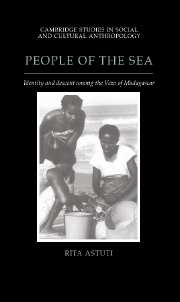Book contents
- Frontmatter
- Contents
- List of illustrations
- Acknowledgements
- 1 Introduction
- 2 Acting Vezo in the present
- 3 People without wisdom
- 4 Avoiding ties and bonds
- 5 Intermezzo
- 6 Kinship in the present and in the future
- 7 Separating life from death
- 8 Working for the dead
- 9 Conclusion
- Notes
- List of references
- Index
- Cambridge Studies in Social and Cultural Anthropology
1 - Introduction
Published online by Cambridge University Press: 30 October 2009
- Frontmatter
- Contents
- List of illustrations
- Acknowledgements
- 1 Introduction
- 2 Acting Vezo in the present
- 3 People without wisdom
- 4 Avoiding ties and bonds
- 5 Intermezzo
- 6 Kinship in the present and in the future
- 7 Separating life from death
- 8 Working for the dead
- 9 Conclusion
- Notes
- List of references
- Index
- Cambridge Studies in Social and Cultural Anthropology
Summary
This is a study of two different forms of identity, one which is achieved through activities performed in the present, the other which is given as an essence inherited from the past; one which is of a recognizable Austronesian character, for it is transformative, non-primordialist and non-essentialist, the other which bears instead a clear African imprint, for it is rooted in, and determined by, the unchangeable order of descent. These two identities are both known to the Vezo, a group of people who live on the western coast of Madagascar. One of the aims of this book is to explore how these two different and apparently incompatible ways of being a person are made to co-exist, and how they are articulated with one another.
In the following pages, I shall introduce the reader to these two identities as I encountered them during my fieldwork among the Vezo. I shall describe how I came to formulate the question that will engage us for the whole of this work; at the same time, I shall begin to provide and to explain the local idiom of identity – the contrast between ‘un-kindedness’ and ‘kindedness’.
A few days after arriving in Betania, a coastal village in western Madagascar, I saw two children, aged about six, playing in the hull of a broken canoe half sunk in the sand. As they paddled with two wooden sticks, they chanted to each other ‘ve-zo! ve-zo!’.
- Type
- Chapter
- Information
- People of the SeaIdentity and Descent among the Vezo of Madagascar, pp. 1 - 13Publisher: Cambridge University PressPrint publication year: 1995

